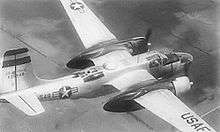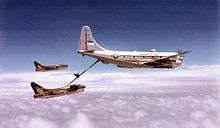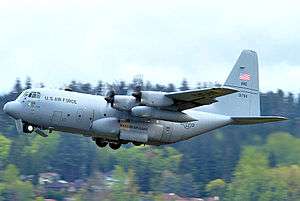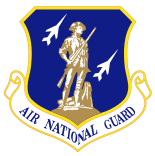180th Airlift Squadron
| 180th Airlift Squadron | |
|---|---|
|
180th Airlift Squadron Lockheed C-130H2 Hercules 90-1794 | |
| Active | 26 June 1942-Present |
| Country |
|
| Allegiance |
|
| Branch |
|
| Type | Squadron |
| Role | Airlift |
| Part of | Missouri Air National Guard |
| Garrison/HQ | Rosecrans Air National Guard Base, St. Joseph, Missouri |
| Tail Code | Grey Stripe "St Joseph" Black Letters |
| Engagements | World War II, Korean War, Desert Shield/Storm, Iraq War, Operation Enduring Freedom |
| Insignia | |
| 180th Airlift Squadron emblem |
 |
The 180th Airlift Squadron (180 AS) is a unit of the Missouri Air National Guard 139th Airlift Wing located at Rosecrans Air National Guard Base, St. Joseph, Missouri. The 180th is equipped with the C-130H2 Hercules.
History
World War II
Activated in mid-1942 as a B-26 Marauder medium bombardment group. Trained under Third Air Force in Louisiana; reassigned to the European Theater of Operations (ETO), being assigned initially to VIII Air Support Command in England in September 1942. Flew several missions over France and Belgium from its base in England during October, then being reassigned to the new Twelfth Air Force in Algeria.
During the North African Campaign, engaged in tactical bomb strikes of enemy targets, primarily in eastern Algeria and Tunisia, including railroads, airfields, harbor installations, and enemy shipping along the Mediterranean Coast.
Squadron returned to French Morocco in March 1943, then returned to combat in June 1943, attacking enemy targets on Italian island in the Mediterranean, including Sicily, Sardinia, and Pantelleria. From bases in Algeria and Tunisia, the group supported the Allied invasion of Italy, bombing bridges and marshalling yards during the late summer and early autumn of 1943.
In November, it moved to Sardinia, to strike Axis targets in central Italy. Early in 1944, the squadron supported Allied ground forces as they advanced in the Cassino and Anzio areas. Later in the year, the group attacked German supply lines in northern Italy, bombing bridges, marshalling yards, and roads. During the summer, it bombed bridges over the Po River in northern Italy to block the stream of German supplies and reinforcements going southward. Supported the invasion of southern France in August 1944 by attacking coastal batteries, radar stations, and bridges. From Corsica, it hit railroad bridges in Northern Italy and late in the year attacked railroad lines through the Brenner Pass that connected Germany and Austria with Italy.
In January 1945, the squadron returned to the United States, where it began to train with A-26 aircraft for operations in the Pacific Theater. Between May and July 1945, moved by ship to Okinawa, and on 16 July flew its first mission against Japan. From then until the end of the fighting in early August, the squadron attacked enemy targets such as airfields and industrial centers on Kyūshū and occupied Shanghai area of China, and shipping around the Ryukyu Islands and in the East China Sea. In November and December 1945, the squadron returned to the United States and was inactivated.
Missouri Air National Guard
The wartime 438th Bombardment Squadron was re-activated and re-designated as the 180th Bombardment Squadron, and was allotted to the Missouri Air National Guard, on 24 May 1946. It was organized at Rosecrans Memorial Airport, St Joseph and was extended federal recognition on 22 August 1946 by the National Guard Bureau. The 180th Bombardment Squadron was bestowed the history, honors, and colors of the 438th Bombardment Squadron. The squadron was equipped with B-26 Invaders and was assigned to the Missouri ANG 131st Fighter Group at Lambert Field, St Louis.
Korean War activation

On 1 April 1951 the 180th was federalized and brought to active-duty due to the Korean War. It was initially assigned to Tactical Air Command (TAC), and moved to Langley AFB, Virginia. At Langley, the 180th Bombardment Squadron was assigned to the federalized 126th Bombardment Group, equipped with B-26 Invaders. The 126th Bomb Group consisted of the 180th, along with the 108th and the 168th Bombardment Squadrons from the Illinois ANG. The aircraft were marked by various color bands on the vertical stabilizer and rudder. Black/Yellow/Blue for the 108th; Black/Yellow/Red for the 168th, and Black/Yellow/Green for the 180th.
After training and organization, the 126th Bombardment Wing was reassigned to the United States Air Forces in Europe and deployed to Bordeaux-Merignac Air Base, France with the first elements arriving in November 1951. By 10 November, Bordeaux was considered an operational base and was assigned to the 12th Air Force. It flew B-26's for training and maneuvers and stayed at Bordeaux AB until being transferred Laon-Couvron Air Base, France on 25 May 1952.
At Laon, the 126th used its B-26's for training and maneuvers until December until being relieved from active duty and transferred, without personnel and equipment, back to the United States where the unit was returned to the control of the Air National Guard on 1 January 1953.
Tactical Air Command
Returning to St Joseph, the 180th was re-formed as a light bombardment squadron in January 1953 and came under Tactical Air Command (TAC). It received B-26 Invaders that returned from the Korean War and trained primarily in night bombardment missions, which the aircraft specialized in while in Korea.
With the removal of the B-26 from bombing duties in 1957 as neared the end of their service lives, the squadron received some F-80C Shooting Star jet fighters and some RF-84F Thunderflash reconnaissance aircraft. They were re-designated as a Fighter-Interceptor squadron on 1 July 1957, then transferred out the F-80s and were re-designated as a Tactical Reconnaissance squadron on 10 April 1958
Air Transport
On 14 April 1962, the 180th was reassigned to Military Air Transport Service (MATS), trading in its Thunderflassh jet reconnaissance aircraft for 4-engined C-97 Stratofreighter transports. With air transportation recognized as a critical wartime need, the unit was re-designated the 180th Air Transport Squadron (Heavy).
With the transfer to MATS, the 180th was authorized to expand to a group level, and the 139th Air Transport Group was established by the National Guard Bureau, the 180th ATS becoming the group's flying squadron. Other squadrons assigned into the group were the 139th Headquarters, 139th Material Squadron (Maintenance), 139th Combat Support Squadron, and the 139th USAF Dispensary.
From St. Joseph, the 180th augmented MATS airlift capability worldwide in support of the Air Force's needs. Throughout the 1960s, the unit flew long-distance transport missions in support of Air Force requirements, frequently sending aircraft to Europe, Alaska, the Caribbean, Hawaii, Japan, the Philippines, and during the Vietnam War, to both South Vietnam, Okinawa and Thailand. With the realignment of MATS to Military Airlift Command (MAC), the squadron was re-designated as a Military Airlift Squadron on 8 January 1966.
Air Refueling

In 1969, military requirements resulted in a change in mission when the group was reassigned from MAC transport duties to the Strategic Air Command (SAC). Under SAC the group became an Air Refueling unit, being with the air refueling version of the C-97 transport, the KC-97 Stratotanker. Familiarity with the aircraft led to a smooth transition from MAC to the new refueling mission. It supported the United States Air Forces in Europe (USAFE) flying aerial refueling missions in the KC-97 supporting missions of deploying aircraft to NATO for tactical exercises.
Tactical Airlift
In 1976 the KC-97s were retired by SAC and the unit was returned to MAC. The 131st was re-equipped with C-130A Hercules tactical airlifters and returned to its transport mission. With the C-130s the 180th supported Operation Volant Oak and Operation Coronet Oak at Howard Air Force Base, Panama.
During a 180th deployment to Howard AFB in November, 1978, they were caught up in a "real world" situation when the world began to learn of the events unfolding in Jonestown, Guyana. The 180th, flying the C-130, was the first US military aircraft landing at Timehri International Airport, Guyana with US embassy officials that they had picked up in Venezuela as well as food and supplies meant for the survivors the Americans hoped to take out of Guyana. That, of course, was before it became apparent that most of the more than 900 Peoples Temple members were lying dead in Jonestown.
In December, 1989, the 180th was once again deployed at Howard AFB when Operation Just Cause began. The 180th flew combat mission in support of the Operation. In late 1980 and through 1983, members of the 180th embarked on a special project to enhance survivability of C-130 aircrews while flying in a hostile environment. The need for this type of training became apparent after C-130 units from the Military Airlift Command (MAC) began to participate in Red Flag at Nellis AFB. It was obvious that the C-130's were not doing well against the ground and air threats posed in the Red Flag exercise. After approval from the National Guard Bureau and tacitly from Military Airlift Command (MAC), they began service test to validate the training program. After more than three service test, the program proved it worth and the Advanced Airlift Tactics Training Center was approved and instituted on 4 February 1984.
In March 1987, the 180th began to receive brand new C-130H2 Hercules aircraft replacing the C-130A model aircraft they had flown for the past ten years. In October 1987, the 180th deployed two C-130H2 aircraft supporting a United States Army Special Forces (SF) and the Royal Australian Special Air Service Regiment (SAS) in a joint personnel airdrop exercise called Badge Anvil 1987 at RAAF Learmonth, Australia. The exercise provided high altitude low opening and high altitude high opening parachute training. Since all of the airdrops occurred above 10,000 feet and as high as 24,500 feet, the 15th Physiological Training Flight, USAF, also supported the exercise and provided supplemental oxygen equipment, training and support for the training missions. Each flight was like going to the altitude chamber.
In 1989, the 180th with four C-130H2 aircraft deployed to Kimhae International Airport, Republic of Korea in support of Operation Team Spirit 1989. During the exercise, the 180th flew challenging missions including tactical resupply, fuel bladder missions, assault landings on short runways including landing on highway landing strips, numerous airdrop missions including both visual, high altitude and radar drop scenarios.
1991 Gulf War
The 180th Tactical Airlift Squadron was ordered to the active service on December 28, 1990, as a result of the Iraqi invasion of Kuwait to support Operation Desert Shield. For some unit members, this would be a return to the Persian Gulf as they had volunteered and deployed with 2 C-130H aircraft, aircrews, maintenance and support personnel, to form the first Air National Guard provisional airlift squadron in September 1990. On January 2, 1991, the 180th TAS and its 8 C-130H aircraft and personnel departed Rosecrans Air National Guard Base for Al Ain Air Base, United Arab Emirates (UAE) and were redesignated as the 1632nd Tactical Airlift Squadron (Provisional) as part of the 1630th Tactical Airlift Wing (Provisional) which was under the 1610th Airlift Division (Provisional). The unit remained at Al Ain Air Base through the air war and the ground war flying combat and combat support missions in support of the allied operations. Beginning on March 22, 1991, the 180th TAS redeployed to Al Kharj Air Base, Kingdom of Saudi Arabia. The 180th TAS departed Al Kharj Air Base on May 28, 1991, and returned to Rosecrans Air National Guard Base on May 30, 1991. When the aircraft arrived home, they had "nose art" on each courtesy of the crew chiefs. The nose art was 391 "Connie Kay", 392 "Desert Possum", 393 "Spirit of St. Joe", 394 "The Hog", 395 "Chief", 396 "Buzzard", 397 "Riders on the Storm" and 398 "Fike's Filly". The 180th TAS was relieved from active duty and released back to state control on June 24, 1991.
During the 1990s, the 180th provided airlift support to the United States Air Forces Europe during the airlift operations into Bosnia and Herzegovina. These operations were named Operation Provide Promise, Operation Joint Endeavor, Operation Joint Guard and Operation Joint Forge. Members of the 180th along with operations support and maintenance personnel would deploy to Rhein-Main Air Base and, after it closed, to Ramstein Air Base and assigned to "Delta Squadron". The Air National Guard would generally be responsible for a 90- or 120-day period and guard members would typically volunteer for duty for a minimum of a two- to three-week period although some would volunteer for longer periods.
Global War on Terrorism
Following the attacks on September 11, 2001, the 180th served in a support role flying missions transporting personnel and equipment in support of Operation Enduring Freedom.
The 180th Airlift Squadron was notified in February 2003 that it would be partially mobilized as a result of the impending conflict in Iraq which would later be known as Operation Iraqi Freedom. The unit deployed in March 2003 to the Iraqi theater and later supported Operation Enduring Freedom in Afghanistan and was released from active duty in March 2006 and reverted to state control. This was a historic partial mobilization that lasted three years. The 180th remained in a state of partial activation for three years until it was released from mobilization in March 2006 and reverted to state control.
Lineage

- Constituted 438th Bombardment Squadron (Medium) on 19 June 1942.
- Activated on 26 June 1942.
- Re-designated: 438th Bombardment Squadron (Light) on 3 February 1945.
- Inactivated on 13 December 1945.
- Re-designated: 180th Bombardment Squadron (Light), and allotted to Missouri ANG, on 24 May 1946.
- Extended federal recognition on 22 August 1946
- Federalized and placed on active duty, 1 April 1951
- Released from active duty and returned to Missouri state control, 1 January 1953
- Re-designated: 180th Fighter-Interceptor Squadron, 1 July 1957
- Re-designated: 180th Tactical Reconnaissance Squadron, 10 April 1958
- Re-designated: 180th Air Transport Squadron, 14 April 1962
- Re-designated: 180th Military Airlift Squadron, 8 January 1966
- Re-designated: 180th Air Refueling Squadron, 6 September 1969
- Re-designated: 180th Tactical Airlift Squadron, 1 October 1976
- Federalized and placed on active duty, 28 December 1990
- Deployed elements designated: 1632d Tactical Airlift Squadron (Provisional), 2 January 1991
- Released from active duty and returned to Missouri state control, 24 June 1991
- Re-designated: 180th Airlift Squadron, 8 April 1992
- Deployed elements designated: 180th Expeditionary Airlift Squadron when assigned to Air and Space Expeditionary units.
Assignments
- 319th Bombardment Group, 26 June 1942.
- VII Bomber Command, 18 December 1945 – 4 January 1946
- 131st Fighter Group, 22 August 1946
- 131st Composite Wing, 31 October 1950
- 126th Bombardment Group, 1 April 1951
- 131st Fighter-Bomber Wing, 1 January 1953
- 131st Tactical Fighter Wing, 1 January 1960
- 139th Air Transport Group, 14 April 1962
- 139th Military Airlift Group, 8 January 1966
- 139th Air Refueling Group, 6 September 1969
- 139th Tactical Airlift Group, 1 October 1976
- Deployed elements assigned to: 1630th Tactical Airlift Wing (Provisional), 28 December 1990-24 June 1991
- 139th Airlift Group, 8 April 1992
- 139th Operations Group, 1 October 1995 – Present
Stations
|
|
Aircraft
|
|
See also
References
![]() This article incorporates public domain material from the Air Force Historical Research Agency website http://www.afhra.af.mil/.
This article incorporates public domain material from the Air Force Historical Research Agency website http://www.afhra.af.mil/.
- Maurer, Maurer, ed. (1982) [1969]. Combat Squadrons of the Air Force, World War II (PDF) (reprint ed.). Washington, DC: Office of Air Force History. ISBN 0-405-12194-6. LCCN 70605402. OCLC 72556.
- 139th Airlift Wing history
- Rogers, B. (2006). United States Air Force Unit Designations Since 1978. ISBN 1-85780-197-0
- Gross, Charles J (1996), The Air National Guard and the American Military Tradition, United States Dept. of Defense, ISBN 0160483026


